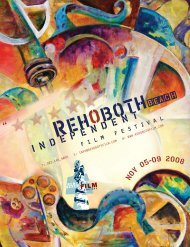nov 10-14 2010 - Rehoboth Beach Film Society
nov 10-14 2010 - Rehoboth Beach Film Society
nov 10-14 2010 - Rehoboth Beach Film Society
Create successful ePaper yourself
Turn your PDF publications into a flip-book with our unique Google optimized e-Paper software.
IndIan fIlm: fRom bollyWood and beyond<br />
<strong>10</strong>:00 am– 11:30 am, thursday, <strong>nov</strong>ember 11<br />
the big tent, behind movies at midway<br />
admission: Free (advance registration is not required)<br />
While much about indian cinema may not be known outside of its borders, the indian film<br />
industry is immense. in the past year, a total of 1,288 feature films were made in india plus<br />
close to 200 shorts, a number higher than anywhere else in the world. While “bollywood” films<br />
(movies that use song and dance numbers) dominant the landscape, this is not the only type<br />
of films that india produces. the independent film is making a surge into theatres in india and<br />
are being widely accepted by citizens, and the world. in 20<strong>10</strong>, india had its first entry ever into<br />
the prestigious (and indie favorite) Sundance <strong>Film</strong> Festival with Peepli live (Page 49) and a slot<br />
in the cannes <strong>Film</strong> Festival with Udaan (Page 54) where an indian film has not been seen in more<br />
than a decade.<br />
india’s vast geography is also evident in its films as each region has distinctive landscapes and<br />
unique stories. more than 24 different languages were represented in 2009 films. While the<br />
central <strong>Film</strong> board of india is the main organization, most of the regions have a board that<br />
helps promote and often produce regional cinema. the governance boards can also have a<br />
dramatic effect on the films themselves as india has a very stringent censorship control<br />
unlike very few other nations. often the censoring process makes it difficult to get a film<br />
made or eventually seen by the people.<br />
in this seminar cynthia cooper from towson University and andrew Sharma of Salisbury<br />
University bring you two sides of indian cinema: one side is the art of indian cinema, including<br />
the craft, cultures and critical response, both domestic and abroad, and the second is the<br />
censorship side and the impact it has on the above issues. While the two may seem mutually<br />
exclusive, they really do go hand in hand on shaping the look and feel of the cinema of india.<br />
dR. CynThIa a. CoopeR<br />
Cynthia is the Chairperson and Associate Professor in<br />
the Mass Communication & Communication Studies<br />
Department at Towson University. She has authored<br />
several books on media law, and teaches media<br />
courses in management, economics and regulation.<br />
She has presented at academic conferences on the<br />
interrelationship of media content and government versus<br />
private sector funding.<br />
dR. andReW shaRma<br />
Andrew Sharma is currently a Professor, teaching audio,<br />
video and digital film production in the Communication<br />
Arts Department at Salisbury University. He has extensive<br />
academic and national and international industry<br />
experience, having worked in the advertising, film and<br />
television industry here and abroad. He is an accomplished<br />
producer and director having numerous documentaries<br />
and commercials to his credit. Recently, he was awarded a<br />
Fulbright Fellowship to teach media in India.<br />
87<br />
semInaRs



